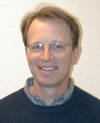June 2004
![]()
AutomatedBuildings.com
[an error occurred while processing this directive]
(Click Message to Learn More)
June 2004 |
[an error occurred while processing this directive] |
 EMAIL INTERVIEW
- Steve Fey & Ken Sinclair
EMAIL INTERVIEW
- Steve Fey & Ken Sinclair
Steve Fey, Vice President of Sales, Tridium, Inc.
Steve Fey has over 20 years of experience in the controls industry including building automation, security automation and industrial controls. During that time Steve has held a variety of senior management positions in sales, marketing and systems engineering. Steve is a graduate of Cornell University with a B.S. in electrical engineering.
The Niagara Appliance
|
[an error occurred while processing this directive] |
Sinclair: What is a Niagara Appliance?
Fey: The Niagara Appliance program is a solution developed for OEM equipment and service providers. In todayís market, OEM suppliers of mechanical and electrical equipment, building control, security, fire and life safety systems are increasingly being asked to web-enable their products, provide interconnectivity to a diverse range of other control systems, and communicate alarm and maintenance information to service personnel remotely over the Internet. The Niagara Appliance has been developed to address this with a cost effective solution that can be brought to market quickly.
A Niagara Appliance is built on Tridiumís core Niagara Framework software platform, so it combines web-based operation, communications to a wide range of standard and proprietary networks, the ability to execute application logic, and the ability to connect to the enterprise into a pre-packaged solution. It gives the OEM a solution that is tailored to their specific needs.
The key to the appliance concept is the ability to configure, operate and service the system directly from a browser. Appliances can be pre-installed at the OEMís factory and later commissioned in the field by a technician using just a laptop computer and standard browser software.
As an example, a chiller manufacturer using a Niagara Appliance is able to sequence multiple chillers, provide Internet connectivity to factory personnel for alarm and maintenance information, while simultaneously communicating to the facilityís BAS system through built-in BACNet or LON network ports. All application logic and control sequences are stored in non-volatile memory, along with web pages that permit an authorized factory technician to set operating parameters, select equipment options, adjust time schedules, and modify setpoints.
Sinclair: What are other examples of companies that would benefit from the Niagara Appliance?
Fey: Virtually any equipment OEM in the commercial HVAC arena that incorporates microprocessor-based controls is an ideal candidate. This would include manufacturers of chillers, boilers, air handlers, package A/C units, etc. Electrical equipment such as lighting control systems, demand meters, UPS and power distribution equipment are also good examples.
Starting with support for all leading open protocols including BACNet, LonWorks, Modbus, and OPC, the Niagara Appliance allows these companies to add a web browser interface to their products, connect to the Internet, and automatically provide remote service capability to their customers.
Sinclair: What makes the Niagara Appliance different from Tridiumís standard products?
[an error occurred while processing this directive] Fey: From a hardware perspective there is no difference. The distinction is in software only and is based on specific utilities that weíve added to the Niagara Framework that allow us to convert what is often considered a programmable controller into a fixed-function device that can be configured from simple menu options in the field with a browser.
Although simple in concept, it is a very powerful difference since we are able to draw upon all of the built-in functionality of the Niagara Framework to meet the needs of a broad range of customer needs, while simultaneously achieving a solution that is both easy to install and service.
Sinclair: What additional benefits does the Niagara Framework bring to Appliance customers?
Fey: Since Appliances are built on the Niagara Framework they automatically inherit advancements in the underlying technology. As Tridium adds support for new protocols for example, Appliance customers immediately benefit. As we know from experience, the number of building automation protocols continues to expand. Tridiumís commitment to stay in front of this trend insures our customers that by basing their offering on the Niagara Framework they are able to stay current with technology and avoid continuous R&D investments in protocol compatibility.
Sinclair: What does it take to create an Appliance application?
Fey: The process begins with the customer defining the scope of work in a functional specification. Depending on the in-house capabilities of the customer, Tridium may be asked to develop all or just a portion of the application logic and user interface that makes up the finished appliance. Typically this process takes from 3 to 6 months to complete. Appliance customers find that as their familiarity grows with the technology they are able to assume an increasing portion of the software development and ongoing support.
[an error occurred while processing this directive]
[Click Banner To Learn More]
[Home Page] [The Automator] [About] [Subscribe ] [Contact Us]